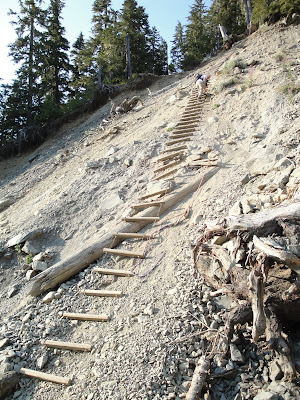
In the last umbilical thread I suggested that instead of clipping into the specifically built attachment points of a tool like the Black Diamond Cobra and Fusion that one might want to rethink that idea and add a cord loop to better keep the "attachment" biner of the various commercial Umbilicals attached.
One of the things I do on occasion is post a link to a thread in other forums where I think others might find the info interesting and more importantly where I'll get some feed back. I did that with the Umbilical "loop" post. You get all sorts of experience levels when you do such things and even more interesting how the terrain of a specific area defines the gear that gets used and is popular as well. All ofwhich I find interesting.
Look here:
http://cascadeclimbers.com/forum/ubbthreads.php/topics/1000731/Umbilicals#Post1000731
http://www.mountainproject.com/v/climbing_gear_discussion/umbilicals/107022451
http://www.ukclimbing.com/forums/t.php?t=443832
http://www.gravsports-ice.com/icethreads/ubbthreads.php?ubb=showflat&Number=8682#Post8682
http://neice.com/forum/ubbthreads.php?ubb=showflat&Number=58508&page=1
http://www.summitpost.org/phpBB3/umbilicals-t57260.html
http://www.rockclimbing.com/cgi-bin/forum/gforum.cgi?post=2453623;sb=post_latest_reply;so=ASC;forum_view=forum_view_collapsed;page=unread#unread
http://www.escaladequebec.com/
I've been using one form of umbilical or another virtually since day one in my own ice climbing. Just seemed like the reasonable thing to do. Chouinard alpine hammers (or big wall hammers) were likely the first commercially.
My thought, and until recently when I changed to a commercial set up, was the umbilical should be able to take "full weight loads" or something like 2000 pounds in my mind.
I've playedaround a lot with umbilicals over the years. Here is a comment I made in March of , here:
http://cascadeclimbers.com/forum/ubbthreads.php/topics/947206/Re_New_Nomic
"4mm is rated to 900#. (which is what I currently use to tie my umbilicals in with) I took a full length fall onto my BD tethers this winter. My first. By full length I mean tool below chest level and that tool catching me at full extension on the other umbilical. As close as I want to get to a 6 or 7 foot, factor 1 fall. I am no fly weight so the load was pretty high I suspect.
Not a tether yet made that will hold a true factor 1 Fall let alone a 2.
But people have already been asking for them. You'll want to rely on good gear and a rated climbing rope for that with a 8 or 9' fall possible on umbilicals/tethers.
Mine you the other tool was placed higher and ripped through the slush causing the fall. The tool that caught me also ripped through a good 12" or more of bad ice before finally catching the fall. Ripping through the ice worked as a natural "screamer" absorbing energy and the fall did "blow" the 4mm enough to easily see it needed to be changed out. But no core showing yet
From an earlier BD email exchange this winter when I asked about the issue of the small BD biner (worried about the sharp edged proto types that I was using. The new Production stuff has much better and rounded edges) on 4 and 5mm cord laced to Nomics with a BD Spinner umbilical.
Black Diamond said:
"Just tested this to 800lbs (single leg). No damage to the 4mm cord or our steel clip (production quality with more tumbling to the part); the bungee webbing breaks first. Then pull tested our steel biner clipped to 5mm cord, this went to 1600lbs before the cord broke."
Not like I want to use 4mm! I would also make sure to use a knot like a dbl Fisherman's in drop form instead of an Over Hand which is typical and much weaker (30% less or more?) in this application. And something like half of the original tensile strength of the rope! Easy bet the cord broke at the knot no matter what knot he was using. But worth hedging your bets here for several reasons. But 4mm seems a good compromise for size (getting it under the pommel or in your hand) and strength. Hanging on a tool is not a dynamic load. Fall far enough and require static cord and webbing to take the dynamic impact load and you'll blow through 5mm or the webbing easily.
More on the dbl fisherman's knot and knot strength.
http://en.wikipedia.org/wiki/Double_fisherman's_knot
http://www.caves.org/section/vertical/nh/50/knotrope.html
More on fall factors
http://www.southeastclimbing.com/faq/faq_fall_factor.htm#add
If you filter through the posts it seems pretty clear what is available currently on a commercial basis could easily be improved upon. Many have done just that already. It doesn't really matter how the companies think the umbilicals should be used...climbers are going to use the umbilicalhow they see fit or make their own. But we all need to be careful. Getting smacked in the head/face/handwith a biner on the end of a sling shotted umbilical is going to be a serious injury. And it has happened already.
My point? Know your ownsystem. Know how strong it is and what your intended use is. I want my umbilicals to be strong enough with some reserveto catch a slip soloing if required...andretain my tools 110% of the time. YMMV




























 I got this bowl at a thrift store. I really like, it just called to me, but hubby didn't care for it. It had no markings on it, and wonder if anyone knows anything about cermanic bowls like this.
I got this bowl at a thrift store. I really like, it just called to me, but hubby didn't care for it. It had no markings on it, and wonder if anyone knows anything about cermanic bowls like this. The crux of the Croz Spur, photos and content courtesy of Dave Searle
The crux of the Croz Spur, photos and content courtesy of Dave Searle Pinocchio, Mont Blanc du Tacul
Pinocchio, Mont Blanc du Tacul Sometimes you just wear gear out and it simply needs to be replaced
Sometimes you just wear gear out and it simply needs to be replaced





